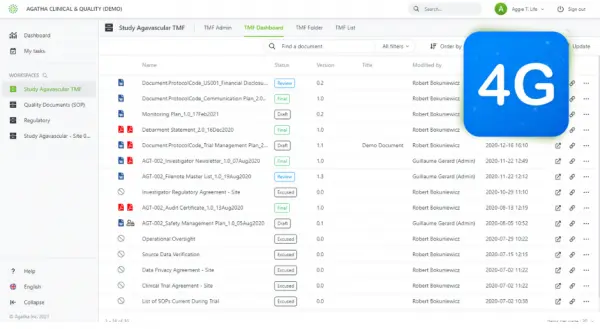Electronic trial master file solutions have gone through several evolutions from complex, highly customized, on-premises platforms to custom off-the-shelf solutions, and all the way to the latest evolution – cloud-based, easy-to-use applications. We are now seeing fourth-generation etmf applications. But how do you know if you’ve found one?
To qualify as a Fourth-Generation eTMF (4G eTMF) application, any solution for managing clinical trial files and documents must include specific capabilities and attributes. Here are ten of the minimum requirements.
1. Cloud-based.
Earlier generations of TMF solutions were based on complex software platforms that you installed “on-premises,” that is, in your own server environment. That created huge costs and complexity, and today is a non-starter. A 4G eTMF application must be cloud-based, so there is no installation on your part. All you need is a log-in and password.
2. Subscription-based.
Software used to be licensed with a one-time, perpetual license. Your license costs were all up front in that model, and vendors were not incentivized to invest in you as a customer. Today, software is provided on an annual subscription basis, a much better arrangement because the vendor has to earn your business each year.
3. Follows the TMF Reference Model.
The Trial Master File Reference Model (TMF RM) Working Group was formed in 2009 by the Drug Information Association (DIA) Document and Records Management Community. The Reference Model provides standardized taxonomy and metadata and outlines a reference definition of TMF content using standard nomenclature. While most organizations will not use the full reference model — they will add additional items and ignore items not relevant to their studies – the Reference Model dramatically simplifies the initial set-up of an eTMF system.
4. Ready-to-Use.
Earlier systems for managing TMF content were based on the idea that you would configure a system extensively based on your own processes. This created long implementation times of six months up to a year to get into production. Today, TMF management processes are so standardized that most of the functionality can be pre-configured and ready to go. A fourth-generation eTMF application should be ready to use in two to three weeks.
5. Prevalidated.
A 4G eTMF is prevalidated so that scripts have been run against the core functionality, and proof of that validation process is available to you. That reduces the validation process immensely because all that is left for you to do is run a final user acceptance test set. With that step plus the vendor’s validation process, the system is fully qualified.
6. Easy to use.
No, I mean really, truly easy to use with a modern user interface. A 4G eTMF should look like an application your kids would enjoy using, not one your parents used. It should leverage modern navigation and user interface features and be completely compatible with use on mobile devices. If a solution you are looking at looks like SharePoint circa 1995, move on.
7. Include eSignatures and Audit Trails.
This is not a differentiator for a 4G eTMF because eSignatures and audit trails are fundamental regulatory compliance requirements. But we do not want to miss the point that, of course, any modern TMF application must address the regulatory rules for the US, EU, Canada, Japan, and any other countries where your studies may execute.
8. Integrate with trial sites.
Clinical study sites produce files and documents throughout a study process, and the process of reviewing and collecting these items from the site is usually a bottleneck. A 4G eTMF application must give sites a way to provide content access to study monitors and CRAs to streamline the process.
9. A REST API.
An eTMF application must include the ability to exchange items with other systems. The Trial Master File is just one of many processes and structures involved in managing clinical trials. For that reason, it is essential that the TMF can easily integrate with and exchange information with other systems. The hallmark of a modern 4G/eTMF is its “REST” API interface architecture, which is the current standard and easiest way to integrate systems. You do NOT want a custom connector between two systems, which inevitably adds cost and complexity.
10. Import, export, and archive.
Studies start, stop, and sometimes get interrupted. The eTMF must be able to take in a set of TMF files that have already been created and to recognize and categorize them. Equally important is the need to “lockdown” a study file as a permanent archive and export it in a complete structure (for example, a Zip file containing PDFs) for transportation to another system or location.
Learn more about fourth generation eTMFs and how to find and implement one in your company. Download the complete guide now.
